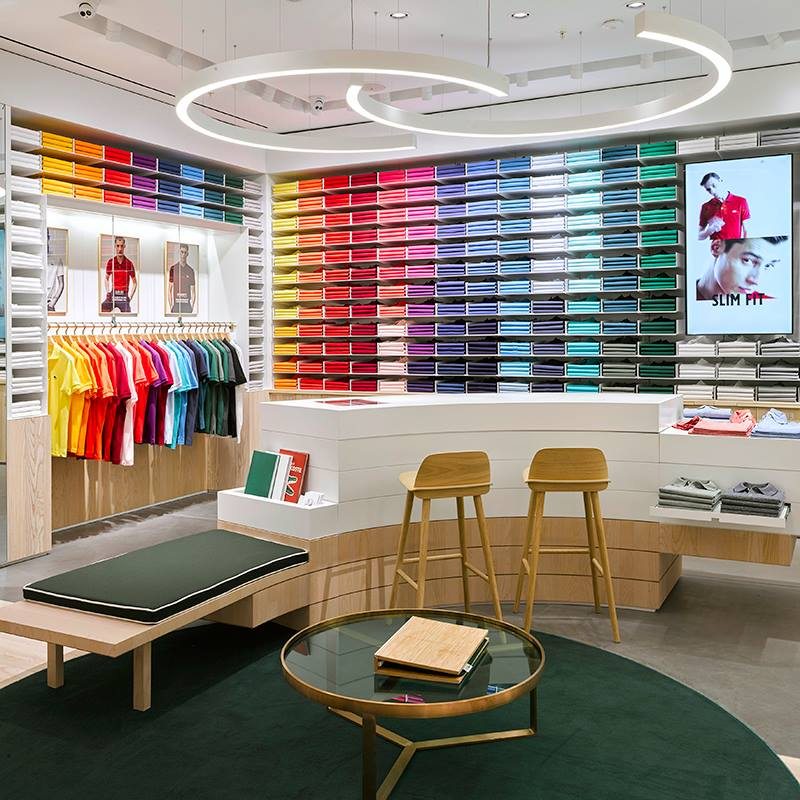
Window Display Design for Fashion Retail Stores**
Window display design is a core element of visual merchandising, attracting customer attention, conveying brand identity, and driving sales through creative arrangements and thematic designs. Below are key design principles and practical techniques:
I. Core Design Elements
1. Thematic Storytelling
- Seasonal Themes: Bright colors + natural elements (e.g., palm leaves) for spring/summer; warm tones + textured fabrics (e.g., faux fur) for autumn/winter.
- Holiday Marketing: Incorporate red and traditional cultural symbols for Chinese New Year; gift box-themed displays for Christmas.
- Brand Narrative: Luxury brands often use minimalism + single focal points, while fast-fashion brands favor bold color contrasts + layered styling.
2. Visual Hierarchy
- Golden Triangle Rule: Place key items at eye level (approx. 1.5–1.8m) and arrange accessories in a pyramid composition.
- Dynamic Installations: Rotating platforms showcase 360° garment details; robotic arms can change poses to capture attention.
3. Color Psychology
- Contrasting colors create impact (e.g., orange-blue for sportswear), while analogous colors evoke sophistication (e.g., muted tones for premium brands).
- Data: Warm-toned displays increase dwell time by 23% compared to cool tones (Retail Design Institute, 2023).
II. Innovative Materials & Technology
- Sustainable Materials: Biodegradable paper decor, recycled fiber mannequins (e.g., H&M’s eco-friendly displays).
- Digital Interaction:
- AR mirrors: Scan QR codes for virtual try-ons.
- Projection mapping: Burberry’s rain projection recreated London ambiance.
- Smart Lighting: Programmable LED lights sync with music; key items should have ~1500 lux spotlighting.
III. Practical Techniques
1. SKU Strategy
- 60% hero products, 30% complementary items, 10% traffic-driving accessories (e.g., belts/hats near exits).
2. Refresh Frequency
- Fast fashion: Weekly updates; luxury brands: 2–3 weeks (aligned with new launches).
3. Cost Control
- Modular props increase reuse rate by 40% (e.g., Zara’s standardized components).
- 3D-printed decor reduces costs by 35% vs. traditional craftsmanship.
IV. Case Studies
Uniqlo: Transparent acrylic tubes suspended T-shirts to emphasize fabric lightness.
LV Travel Theme: Vintage trunks + holographic maps boosted conversions by 18%.
Local Brand Innovation: A Chinese brand used origami landscapes, generating 1M+ social media impressions.
V. Pitfalls to Avoid
- Overcrowding (limit to 5–8 items).
- Lighting temperature must complement fabrics (warm for wool/cotton, cool for tech fabrics).
- Regular glass cleaning (fingerprints/dust reduce footfall by 27%).
By integrating systematic theme planning, precise visual calculations, and technology, windows become a brand’s "silent salesperson." Conduct quarterly A/B tests (e.g., comparing color schemes) for continuous optimization.

Shanghai Yongcheng Display Co., Ltd.
Address: No. 2305 Xinjian 1st Road, Jiading District, Shanghai,China
Email: conniegao@ycexhibition.com
Website: http://www.ycyoco.com
Professional Display Cabinet Design and Manufacturing Factory
Schedule a free consultation with our design team.
Contact Us WhatsApp:0065-88197209july@ycyoco.com
telegram

Commercial Space Design Custom Displays Capabilities Cases Blogs Contact
Large Commercial Space Design Retail Store Design Window Display Design Urban Public Space Design Hotel Space Design Cultural Travel Project Design Creative Space Design Trade Show Design More Solutions
© 2025 Shanghai Yongcheng Display Co., Ltd. All Rights Reserved.
Privacy Statement Terms & Conditions Sitemap